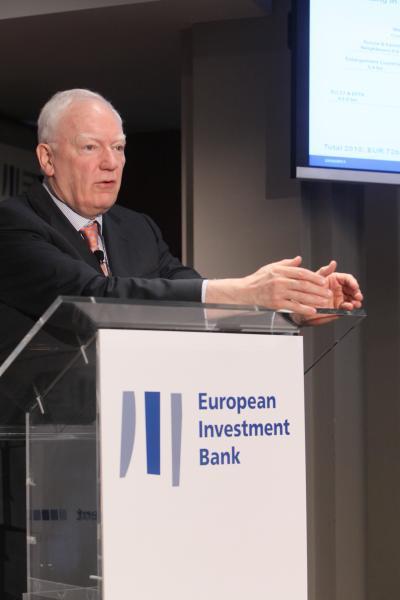
In 2010, the European Investment Bank (EIB) increased financing for climate action projects to EUR 19 billion, representing an impressive 30% of its lending in the European Union. Significantly up from EUR 16 billion the year before, this is a new landmark in supporting sustainable growth and building a low-carbon future in Europe.
In 2010, total EIB lending reached EUR 72 billion – EUR 63 billion in the EU and EUR 9 billion outside the EU – supporting over 460 large-scale projects. This marks a gradual return to pre-crisis levels as the Bank adapts its activity to the economic environment.
The EIB continued its critical contribution to European recovery and completed delivery of an additional EUR 61 billion support package over the last three years, EUR 11 billion more than originally envisaged. Small and medium-sized enterprises – which find it particularly difficult to obtain access to finance in challenging economic circumstances – and less advanced regions in Europe were the main beneficiaries of this exceptional effort. Over this three-year period, more than 160,000 SMEs received finance from the EIB. Less advanced regions in Europe were supported during this period through the financing of 430 projects.
EIB President Philippe Maystadt said: “We have succeeded in our mission to support recovery in Europe by financing projects that stimulate growth, innovation and jobs, and we are very proud of our record volume on climate action projects. Building a better and more sustainable future is the driving force behind everything we do.”
The focus of EIB support for climate action projects remains energy (renewable energy and energy efficiency) and sustainable transport.
The Bank made a successful effort to increase the share of renewable energy and energy efficiency in its portfolio. More than EUR 6 billion of financing supported renewable energy and over EUR 2 billion energy efficiency projects in 2010. National renewable action plans have proved to be an important enabler of investment in these areas and all three emerging technologies, wind, solar and biomass, were supported. In the transport sector, the EIB is playing a leading role in supporting the development of electric vehicles.
Countries outside the EU received EUR 2 billion in climate action financing in 2010. In the coming three years, the Bank will substantially strengthen its support for sustainable energy projects in these countries. This is due to the EUR 1.5 billion increase agreed for the Energy Sustainability Facility, which brings the overall amount to EUR 4.5 billion. This, together with the proposed EUR 2 billion climate change mandate currently being discussed by the European Parliament and Council, puts the Bank in a good position to help the EU implement its global climate action goals outside Europe.
Looking ahead, the EIB will help to implement the Europe 2020 strategy, the EU’s climate action targets and its external policy objectives. It will continue to provide long-term finance and technical expertise and will strive to develop new instruments with the Commission to provide additional risk-bearing capacity for priority sectors such as infrastructure and SMEs.
In 2010, the Bank reported a net profit of EUR 2.1 billion.
Notes for the editor:The European Investment Bank is the long-term lending bank of the European Union.
Its main task is to contribute towards the integration, balanced development and economic and social cohesion of the EU Member States.
Besides supporting projects in the Member States, its lending activities also include financing investments in future Member States of the EU and EU partner countries.
The EIB raises substantial volumes of funds on the capital markets, which it lends on favourable terms to projects furthering EU policy objectives.
It is the largest supranational borrower and its consistent AAA rating is underpinned by firm shareholder support, a strong capital base, excellent asset quality, conservative risk management and a sound funding strategy.
Climate action projects are projects in the areas of energy efficiency, renewable energy, transport, forestry, innovation (RDI) and climate adaptation. To qualify as climate action projects, they have to meet stringent criteria for their contribution to CO2 reduction, energy efficiency goals or sequestration of CO2. Only projects involving the most innovative technologies (e.g. solar, wind, biomass) qualify. Alternatively, the climate adaptation component will have to account for at least 50% of the total project cost.

Photographer: EIB ©EIB
Download original

Photographer: EIB ©EIB
Download original

Photographer: EIB ©To be defined
Download original

Photographer: EIB ©EIB
Download original

Photographer: EIB ©EIB
Download original

Photographer: EIB ©EIB
Download original